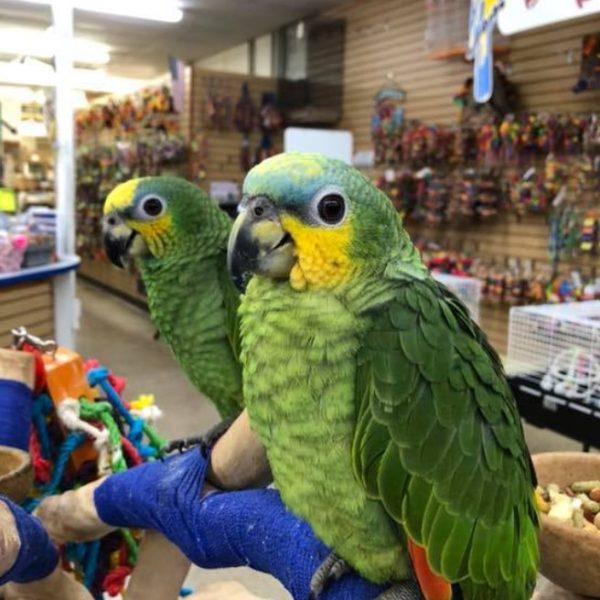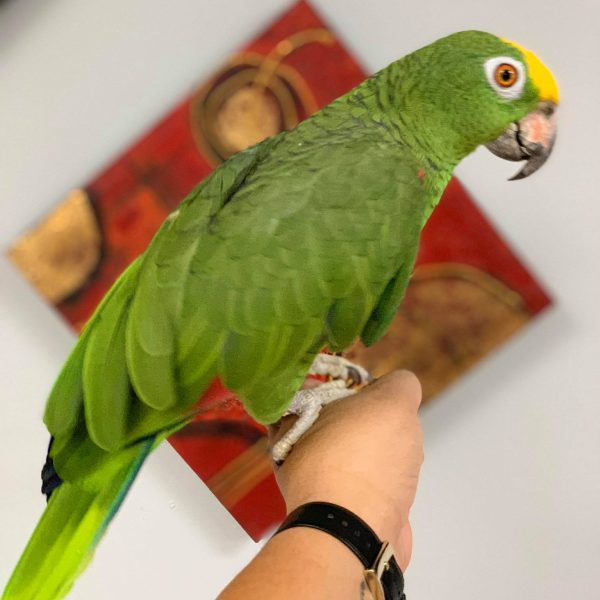Yellow Shoulder Amazons are a great species. They are a smaller species of Amazon with a fantastic personality. Yellow Shoulders can vary slightly in coloration, but as a typical Amazon, they are a gorgeous iridescent green but with yellow and blue splashes. They make great family companions and can be outstanding little talkers. All our birds are very well socialized and used to everyday household activity.
The yellow-shouldered amazon, also known as the yellow-shouldered parrot, is a parrot of the genus Amazona found in the arid areas of northern Venezuela, the Venezuelan islands of Margarita and La Blanquilla, and the island of Bonaire. It has been extirpated from Aruba and possibly also Curaçao.
Yellow-shouldered Amazons can probably live up to 50 to 60 years or more.
Appearance and Personality
Yellow-shouldered Amazons are bright green with a face variably colored with blue, yellow, and white. They are somewhat similar in appearance to blue-fronted Amazons but are distinguished by size (yellow-shoulders are smaller) and facial coloration. Yellow-shoulders have yellow on the face and crown with pale coloration on the forehead and white eye-rings. Extensive patches of yellow-tipped in red adorn the shoulders, and the wing speculum is red. Primary and secondary flight feathers are green with blue tips, and tail feathers are green with yellowish-green tips. The beak is horn colored.
Yellow-shouldered Amazons, which are seldom available as pets, have moderate to low speaking ability. Still, they are intelligent, inquisitive, and very assertive. In general, males are much more common than females and tend to become quite aggressive. Juveniles are generally tame and can be handled for a short time. They are active by nature and are not so prone to obesity as other Amazons.
Yellow-shouldered Amazons should always be provided with toys, blocks of wood, or branches that they can chew. To ensure safety, companion Amazons should not be allowed unsupervised freedom in the home as they often encounter toxins or dangerous items. Young Amazons should be socialized with many people and exposed to various situations such as new cages, toys, visits to the veterinarian, handling by friends, and wing and nail clips to avoid the fear of novel situations.
Feeding
Amazons should be fed a formulated (pelleted or extruded) diet as a basis for good nutrition. The diet should be supplemented with fresh fruits and vegetables daily to add variety and psychological enrichment. Feed approximately 1/4 cup of formulated diet and 1/4 cup of fresh fruits and vegetables daily. Monitor food intake. Overfeeding leads to pickiness, selective feeding, and wasteful throwing of food. Because they tended to obesity, Yellow-shouldered Amazons should be offered seeds or nuts by hand as treats for bonding. Vitamin supplements are not needed for birds eating a formulated diet.
Grooming
Routine bathing or showering is vital to maintaining good plumage and skin condition. Birds can be misted and allowed to dry in a warm room or in the sun, or gently dried with a blow-drier. Care should be taken not to clip the wing feathers excessively as Amazons often fall and injure themselves. Clip only the primary flight feathers and only enough so the bird will glide to the floor. Yellow-shouldered Amazons are relatively light-bodied and require removal of more flight feathers than most Amazons.
Housing
Yellow-shouldered Amazons are very active and should be provided the largest cage that space and budget allows. Ideally, the cage should provide room for flight. Durable cage construction is not as critical as it is for macaws and cockatoos. Still, locks or escape-proof latches may be necessary. Ideally, the bird will have an outdoor cage to allow playtime in the fresh air and sunlight.
Breeding
Yellow-shouldered Amazons are relatively difficult to breed in captivity. In North America, Yellow-shouldered Amazons breed predominantly in the spring and have a limited breeding season typically from February or March to June or July. Clutch size is typically 3 to 4 eggs. A good choice for cage construction is 1-inch by 1-inch by 14-inch gauge welded wire or 1-inch by 1-inch welded wire. A suggested size is 4-foot by 4-foot by 8-foot long suspended 4 feet above the ground or floor. Breeding males can become very aggressive toward the keeper, often attempting to bite while being fed.
A wooden nest box approximately 10 inches by 10 inches by 28 inches can be used.
The incubation period is approximately 24 to 26 days. Chicks will usually fledge at approximately 10 to 12 weeks of age. Yellow-shouldered Amazons are relatively easy to hand-rear. Most hand-rearing formulas can be used successfully.
Male yellow-shoulders are often aggressive toward their mates, especially in response to the keeper’s visits. Clipping the male’s wings before the breeding season may be necessary to help the female escape.
Yellow-shoulders can be noisy when in breeding condition. Take care to consider your neighbors when breeding Amazons.










Reviews
There are no reviews yet.